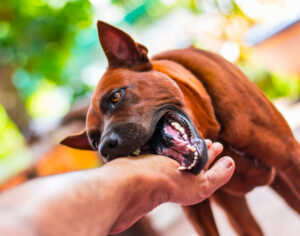As much as we love dogs, it’s essential to remember that they can sometimes behave unpredictably, leading to unfortunate incidents like dog bites. If you or someone you know has experienced a dog bite in Stafford County, Kansas, seeking immediate medical treatment is crucial. This article aims to guide you through what to expect when dealing with a dog bite in Stafford County and the requirements you should be aware of. Remember, acting promptly can prevent complications and ensure a smooth recovery.
Immediate Response
When a dog bite occurs, the first priority is to take care of the injured person. If the injuries are severe, do not hesitate to call 911 for immediate assistance. For less severe bites, follow these initial steps before seeking medical treatment:
- Clean the Wound: Rinse the bite wound gently with soap and water to reduce the risk of infection. Pat the area dry with a clean cloth.
- Control Bleeding: If the wound is bleeding excessively, apply gentle pressure with a clean cloth or bandage to control it.
- Apply an Antibiotic Ointment: After cleaning the wound, apply an over-the-counter antibiotic ointment to prevent infection.
- Cover the Wound: Use a sterile bandage or gauze to cover the wound. Avoid wrapping it too tightly to allow for proper circulation.
Medical Treatment
Once the initial first aid has been administered, it’s essential to seek professional medical treatment for a dog bite, regardless of the bite’s severity. In Stafford County, Kansas, the process typically involves the following steps:
- Visit the Nearest Healthcare Facility: Go to the nearest hospital emergency room, urgent care center, or primary care physician’s office for evaluation and treatment. It’s crucial to have a medical professional assess the wound to determine the appropriate course of action.
- Assessment and Treatment Plan: The healthcare provider will assess the severity of the dog bite, checking for any signs of infection or potential complications. Based on the assessment, they will create a treatment plan tailored to the individual case.
- Wound Cleaning and Closure: If the wound is deep or jagged, it may require cleaning and closure through stitches, staples, or adhesive strips. Proper wound closure is essential to prevent infection and promote healing.
- Tetanus Shot: The healthcare provider may administer a tetanus shot if the injured person hasn’t had one within the past five years. Tetanus vaccinations are necessary to protect against bacterial infections.
- Antibiotics: In some cases, the healthcare provider may prescribe antibiotics to prevent or treat infections, especially if the bite is severe or shows signs of infection.
- Pain Management: The healthcare provider may recommend pain medication or topical treatments to manage discomfort and pain associated with the dog bite.
- Observation and Follow-up: Depending on the severity of the bite, the injured person might be advised to return for follow-up appointments to monitor the wound’s healing progress and address any concerns.
Reporting the Dog Bite
In Stafford County, Kansas, reporting a dog bite is vital for public health and safety reasons. It helps local authorities track potentially dangerous dogs and prevents further incidents. When a dog bite occurs, follow these reporting steps:
- Contact Local Animal Control: Inform the local animal control agency about the incident. They will take note of the incident details and investigate the circumstances surrounding the dog bite.
- Provide Information: When reporting the dog bite, be prepared to provide essential information, such as the date, time, and location of the incident, a description of the dog, and any details about the dog’s owner or handler, if known.
- Cooperate with Authorities: It’s crucial to cooperate fully with animal control officers or law enforcement during the investigation. They will work to determine the dog’s vaccination status and any history of aggressive behavior.
Dog Bite Requirements in Stafford County
Stafford County, Kansas, may have specific requirements related to dog bites. It’s essential to be aware of these requirements to ensure compliance and avoid potential legal consequences. Some common requirements include:
- Quarantine of the Dog: If the dog involved in the bite incident is not up-to-date on its rabies vaccinations, it may be required to undergo a quarantine period to monitor for any signs of rabies. This is a precautionary measure to protect public health.
- Leash Laws: Stafford County likely has leash laws in place that require dogs to be on a leash when in public spaces. Violation of leash laws may result in fines or penalties for the dog’s owner.
- Vaccination Records: Dog owners may need to provide proof of current vaccinations, including rabies if the dog is involved in a bite incident.
- Dog Bite Reporting: As mentioned earlier, reporting a dog bite to local authorities is typically a requirement. Failing to report the incident may lead to legal consequences.
Preventing Dog Bites
While it’s essential to know what to do when seeking medical treatment for a dog bite, prevention is always the best approach. Preventing dog bites not only protects potential victims but also helps maintain a positive relationship between dogs and humans in the community. Here are some tips to prevent dog bites in Stafford County:
- Socialization and Training: Properly socializing dogs from a young age can help them become more comfortable around people and other animals. Additionally, obedience training can teach dogs to respond to commands, reducing the likelihood of aggressive behavior.
- Supervise Interactions: Always supervise interactions between dogs and children or unfamiliar individuals. This is particularly important when introducing a dog to new situations or people.
- Recognize Warning Signs: Learn to recognize warning signs of potential aggression in dogs, such as growling, baring teeth, or raised fur. If you notice any of these signs, give the dog space and avoid approaching it.
- Respect a Dog’s Space: Never approach an unfamiliar dog without the owner’s permission. Respect the dog’s space and avoid making sudden movements or loud noises that could startle the dog.
- Avoid Teasing or Provoking Dogs: Teach children not to tease or provoke dogs, even if they know the animal well. Respect the dog’s boundaries and avoid any behavior that could be perceived as threatening.
- Secure Fencing: If you own a dog, ensure that your property has secure fencing to prevent the dog from escaping and potentially causing harm to others.
- Spaying and Neutering: Spaying or neutering dogs can reduce aggression and the likelihood of roaming, which may lead to confrontations with other animals or people.
- Educate Children: Educate children about dog safety, emphasizing the importance of approaching dogs cautiously and asking for the owner’s permission before petting them.
- Report Aggressive Dogs: If you encounter a dog displaying aggressive behavior or acting in a threatening manner, report it to the local animal control authorities.
- Lead by Example: Be a responsible dog owner and lead by example. Show kindness, patience, and proper control over your pet when in public spaces.
If you require experience legal assistance in Stafford County, Kansas, or surrounding areas, don’t hesitate to contact Melinda Young. Our experienced team is dedicated to providing top-notch legal representation in various areas of law, including personal injury, family law, estate planning, and more. Visit our website or call us now to schedule a consultation and get the support you need for your legal matters. Your rights and best interests are our priority – trust the Melinda Young Law Firm to be your reliable legal partner.
